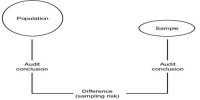The relationship between Test of Control and Assessing Control Risk –
The relationship between the test of controls and assessing control risk is that the planned test of controls are performed during fieldwork and should provide evidence of the proper and consistent application of control policy or procedure throughout the entire year under audit.
The procedure to test the effectiveness of controls in support of a reduced assessed control risk is called tests of controls. A test of controls is an audit procedure to test the effectiveness of a control used by a client entity to prevent or detect material misstatements. Assessing control risk is the process of evaluating the effectiveness of an entity’s internal control structure in preventing or detecting material misstatements in the financial statements.
They are not ordinarily performed under the primarily substantive approach. However, such tests are performed when, based on favorable result concurrent tests of control, the auditor decided to switch from the primary substantive to the lower assessed level of control risk approach.
In this circumstance, the tests are sometimes called additional tests of control. They are performed only when it is likely that additional evidence will be obtained to lower the initial assessment of control risk and it is cost-efficient to do so. These tests are also performed as part of an initial lower assessed level of control risk strategy for specific assertions and they are performed to support the initial planned assessed control risk of moderate or low and the corresponding planned level of substantive tests.
















